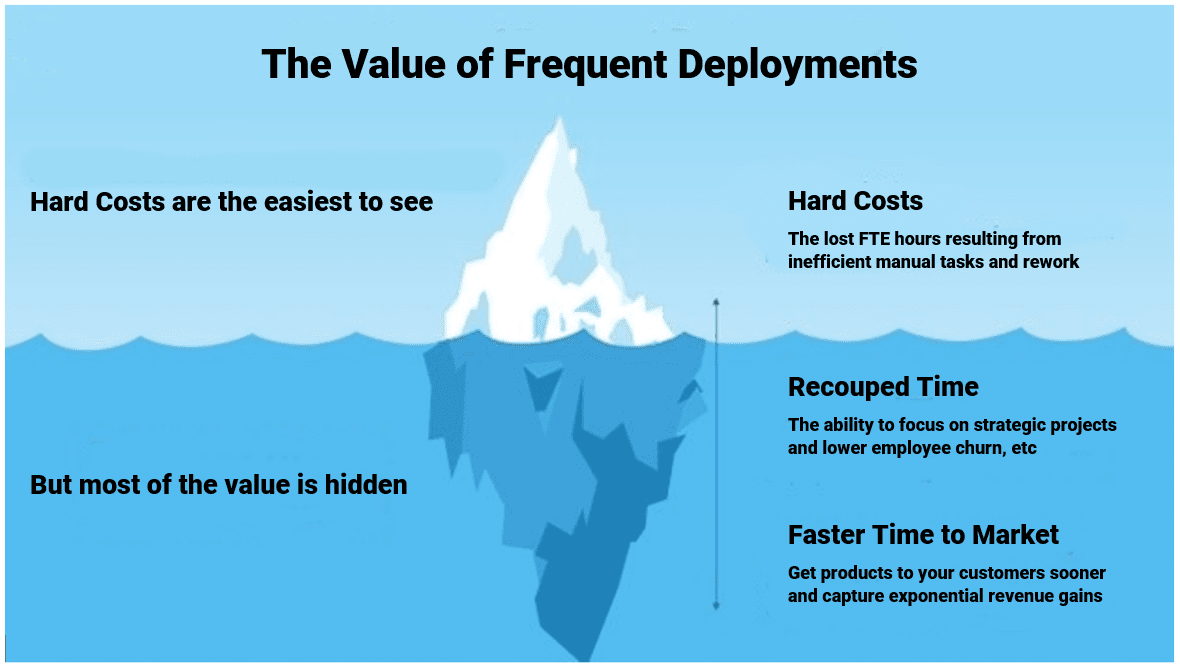The business value of frequent deployments: Faster time to market
 In this series, we’ve been exploring the different layers of business value you can gain from deploying software more frequently. We’ve already looked at the hard costs you can save, and the valuable developer time you can recoup.
In this series, we’ve been exploring the different layers of business value you can gain from deploying software more frequently. We’ve already looked at the hard costs you can save, and the valuable developer time you can recoup.
But that’s not the end of the story. Not by far. Picture an iceberg. The top, the visible part, is those hard costs. Just beneath the surface is that time that can be gained by redeploying wasted time to projects that matter.
Now it’s time to look at the rest of the mass beneath the surface – the time to market, which is the largest and most consequential value layer for your business.
Yes, time to market is a buzzy phrase and you see it everywhere, but I believe its impact is understated because we treat it as such. An often cited McKinsey study outlines the penalties for not meeting time to market targets:
- Products six months late to market earn 33% less profit over five years
- Products released on time but 50% over budget only cut into profits 3.5%
What should also be noted here is that time to revenue is much longer than time to market, and products that take nine months to release may not deliver significant revenue for 18 months.
A good way to illustrate this is to game out release schedules over a reasonable period and see the drastic difference between even small improvements.
Say you release every seven days and you’re able to improve that slightly to six days (an odd cadence to be sure, but just follow me for a moment). Over the course of a year, you’ll save 52 days, so the release that would normally be in July of next year is instead launching to your users in May. Over the course of three years, you’re delivering almost half a year early.
If you’re able to improve from releasing every two weeks to weekly, you’re now doubling your speed to market. You’ll be delivering products in 2023 that would normally be scheduled in 2024.
Quantifying the value you will subsequently gain requires estimating end user benefits at scale. This will obviously change depending on your line of business, what software you’re shipping, and who your customers are. For example, if you’re in finance and the main users of your application are advisors, how much will advancements in your product – getting better information to them faster – help them in their job? Across 500 or 1,000 advisors, how much revenue would that produce for the company on a quicker time scale?
If you’re delivering directly to customers, what does an extra year of new money-making features bring into the business? This is the most important number to quantify because it is, by definition, the core reason to invest in process improvement.
Understanding the full impact of releasing more frequently will define the scale and urgency of any project. Think of it as compound interest. The earlier you make the investment, the greater your future returns become. Each day your business delays committing to process improvements is another day where you’re setting fire to future revenue. Are your competitors doing the same?
To determine the value obtained from faster time to market, consider the following questions:
- Can you quantify the revenue generated by your applications, new and legacy? If so, how much? If not, who in the business can answer that question?
- How many users do those applications have?
- What’s the estimated revenue of new apps, new features, or performance improvement?
- Over a time scale that is meaningful to your business – 3 years, 5 years, 10 years – what is the compound value of delivering earlier?
- What is the estimated value of retaining current customers or attracting new customers via improved products?
Demonstrate and deploy business value quickly
As mentioned at the beginning of this post, the bulk of the business value of more frequent deployments is hidden beneath the surface. Hard costs saved, the most obvious, will be the smallest number because it’s fairly fixed, but when you start to include the impact of focusing more time on revenue generating projects and then the exponential ROI of end-user efficiency, the total mass of impact on your business expands considerably.
The preciseness of the numbers you compile during this journey will be debatable, but that’s not the point. They will get you much closer to understanding the business value than not considering them at all. Once you have an agreed-upon value for your organization – and not just time saved for developers – you’ll be able to assess, strategize, and invest in better processes to achieve goals that are aligned with your business. And have the metrics to measure your efforts by.
Read the other posts in this series to understand more about how you can understand, plan, and measure an initiative to release the value of frequent deployments:
- Part 1: The business value of frequent deployments: Hard costs
- Part 2: The business value of frequent deployments: Recouped time
- Part 3: The business value of frequent deployments: Faster time to market